
The world of sales, when you get down to it, is all about leads. Without people to sell your product or service to, you’re never going to be able to be a success as a business. And without an effective way to manage those leads, it’s going to be incredibly difficult to keep on top of your pipeline and make sure your deals are all moving in the right direction.
But effective lead management goes way beyond simply keeping track of and organizing your future conversion opportunities. There are a number of different elements to creating and maintaining a high-level lead tracking system.
In the following article, we’ll be walking you through practical strategies and tools you can put into place right away in your own sales day-to-day, ensuring nothing slips through the cracks and you’re setting yourself up for long-term success.
Understanding Lead Tracking
In basic terms, lead tracking involves monitoring every interaction with prospects, all the way from initial contact and outreach through the various stages of the process until the deal is either closed or lost.
Having such a methodical system in place allows modern sales teams to nurture their prospect relationships in a structured, thoughtful way, reducing the chances of human error damaging the team’s performance and boosting everybody’s potential for ongoing conversion improvement.
Once you’ve got a handle on the top-down importance of tracking leads as part of a broader sales system, you’ll be able to jump into optimizing your own process and setting yourself up as individuals and a team.
You Need to Define What Exactly a Lead Is
However, before we dive too deeply into tracking leads, it’s important to have an idea of what qualifies somebody as a lead for your business. After all, not every single individual is going to eventually purchase your product or service, so it doesn’t make any sense to treat each prospect equally.
With resources like time and energy being at a premium in today’s fast-paced sales landscape, you need a way to ensure you’re allocating the majority of your efforts toward leads that stand the best chance of eventually converting.
Qualifying what leads actually are is going to be a hugely industry-dependent procedure, and indeed will vary based on your own team’s internal practices and priorities as much as on the actual products or services you’re selling.
But no matter what area you work in, there are a few general questions that will help you to understand who counts as a lead, who doesn’t, and how to keep the most promising prospects on top of the pile going forward.
It’s always a good idea to take a few moments with your team and discuss some of the following criteria from a bird’s-eye-view perspective:
Interest Level: How interested are they in your product or service?
Some leads are going to be more keen than others. That’s just the nature of sales. By having a clear sense of who’s really interested and who’s more lukewarm, you’ll be able to prioritize the most promising contacts and focus on driving them through your pipeline, rather than expending unnecessary amounts of time and energy on less engaged potential customers.
This doesn’t mean they should be ignored, of course. Any lead is a potential customer, and sometimes deals can spring up from the most unexpected of places. Every sales professional has countless stories of times they thought they’d lost a prospect altogether, only for them to pop back up, red hot and ready to convert.
But focusing on the most interested prospects, while allowing you to give the best of your energy and attention to the most promising scenarios, will still leave you with enough juice in the tank to quietly pursue those who, for whatever reason, are just a bit less keen.
Demographic Information: Do they fit into your target market?
It seems like a basic concept, but you might be surprised by just how much even the most seasoned sales professionals can forget to laser-focus on the target market question.
Sometimes, leads who might’ve demonstrated interest simply aren’t a part of your audience. This is a situation that could arise from a number of different circumstances, but the most common one is prospects being confused about what it is you’re actually offering and how much they need it.
This can often lead to a fork-in-the-road situation, whereby you’ll have to decide whether a prospect is actually ever going to convert or not—and as a result, whether you should be expending time and energy on them. If you’ve got somebody in your pipeline who seems super interested but shares nothing in common with the rest of your target audience, there’s probably a reason for it, and it might be worth investigating before pursuing the opportunity too eagerly.
Behavioral Actions: Have they taken any actions that signify buying intent, such as downloading a white paper, signing up for a webinar, or requesting a demo?
Every single step a prospect takes that interacts with your business in some way should be considered as an active sign of intent. With the internet being as demanding and content-saturated as it is nowadays, nobody wants to go through unnecessary friction if they can avoid it.
So even zero-cost actions, like downloading a free white paper or signing up for a webinar, should be taken into consideration during the lead qualification process. And if they’ve gone so far as to request a demo or devote more of their time to understanding your product or service, they should be considered especially hot in terms of intent levels.
Different businesses that offer different products and services will have a range of potential ways for prospects to demonstrate buying intent. There’s no one-size-fits-all, cookie-cutter answer for how to qualify intent. The best results are going to come from deeply understanding your own offering and using that level of comprehension to decide what a sign of major intent actually looks like, as opposed to the kind of passing interest that deserves an alternative level of qualification.
The Vital Importance of Using a Customer Relationship Management (CRM) System
Now that you’ve got a handle on how to go about qualifying your leads and making sure you’re categorizing each prospect correctly, it’s time to discuss actually monitoring them. When it comes to this part of the lead tracking process, Customer Relationship Management (CRM) systems are absolutely indispensable.
These software programs offer a highly developed feature suite targeted at sales professionals, designed to augment every aspect of their workflow from contact information and interaction records to monitoring deal progress and even automating repetitive tasks.
Some of the major value-add functions provided by CRM programs include:
Storing Detailed Contact Information
Keeping all relevant information about each lead in one place takes a massive headache off your plate and makes it easy to stay on top of dozens of concurrent deals, without worrying about dropping the ball on any of them.
Recording Interactions
CRMs help you log every interaction, whether it’s an email, phone call, or in-person meeting. This gives you instant visibility into each customer’s journey and allows you to focus your efforts on what’s going to work best for that particular deal.
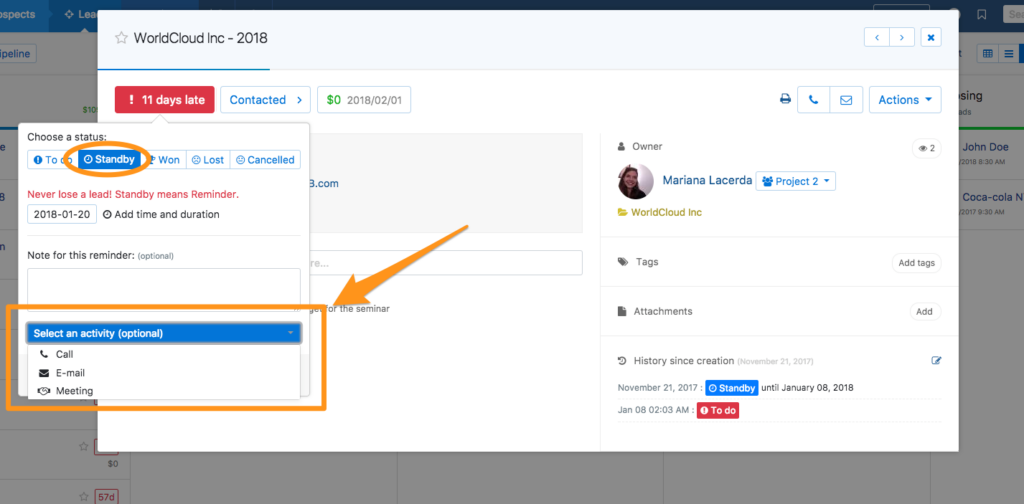
Monitoring Lead Progress
Tracking where each lead is in the sales process is one of any CRMs biggest value-adds. With Kanban-style pipelines, you can easily drag-and-drop leads through the pipeline as the deal progresses, helping you stay focused and locked in all the way until the deal is closed.
Automating Tasks
By helping you set reminders for follow-ups, sending automated emails, and automatically updating prospect records with new information, CRMs minimize a lot of tiresome busywork and free up your own personal bandwidth to spend on more engaging, human-centric tasks.
Following Up on Leads with noCRM
noCRM was designed to make the sales process as seamless as possible for reps at every stage in their careers, and the functionality for following up on leads is no different. There are a number of different ways to view your leads, depending on what suits your own style of sales best:
Pipeline View
The Pipeline View gives you a bird’s-eye perspective on your entire pipeline, helping you understand each lead in the context of your broader task load.
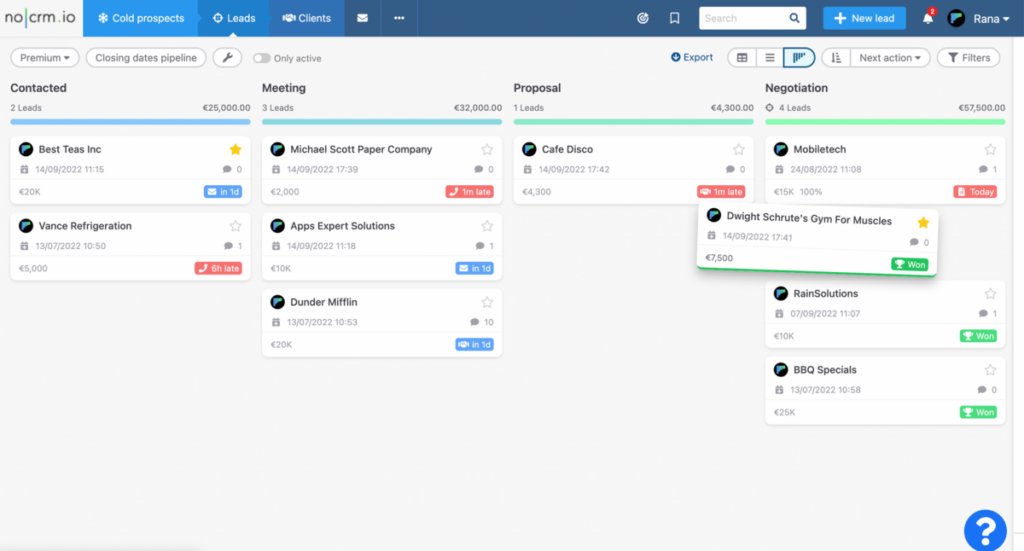
Compact View
The Compact View is perfect for reducing the amount of detail you’re looking at and laser-focusing on the most important aspects of the lead in question.
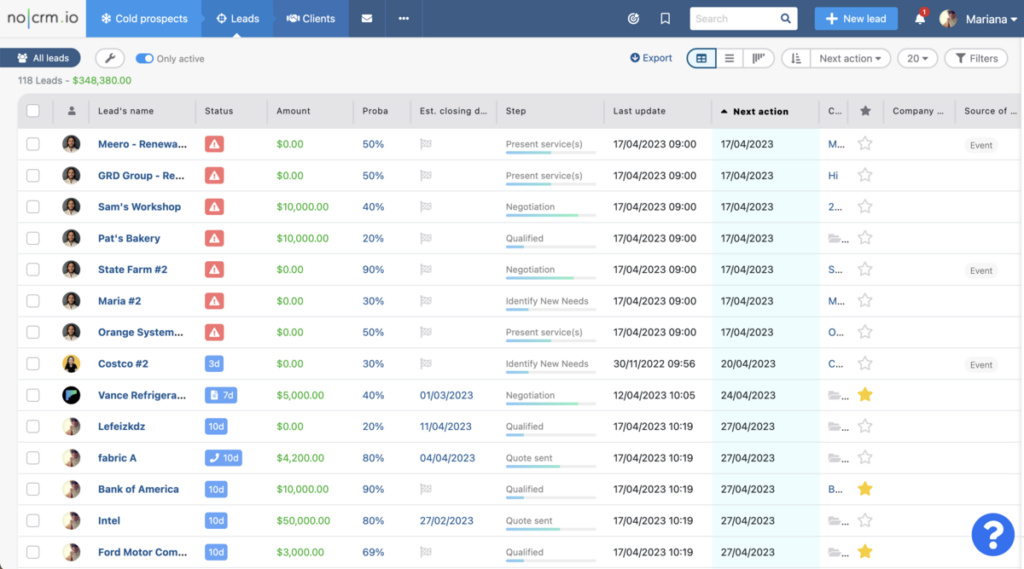
Extended View
For when you need a deeper dive into every element of your relationship with a lead, noCRM’s Extended View gives you all the insight you need to sell with confidence.
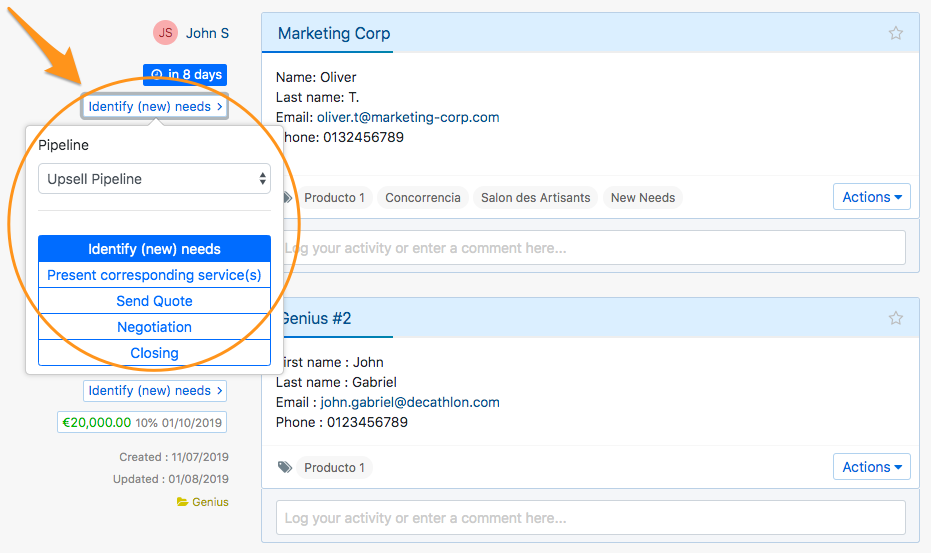
Defining Activities and Contacting Leads with noCRM
The last thing any rep wants to happen is losing out on a potential deal because they forgot to take a certain step in the follow-up process. Luckily, noCRM makes sure you’ll never have to worry about missing anything.
By pre-defining sales activities, you’ll be locking in your own ideal process and ensuring nothing slips through the cracks. Plus, automated reminders keep you on top of everything you’ve got on your plate, no matter how many deals you’re juggling.
To learn more about how to set up and manage sales activities with noCRM, click here.
And when it comes to the work of actually getting in touch with your contacts, that’s easy, too. VOIP and email software integrations make it possible to reach out directly from within the software itself, so whether you need to send a quick message or you feel that a call is more appropriate, we’ve got you covered.
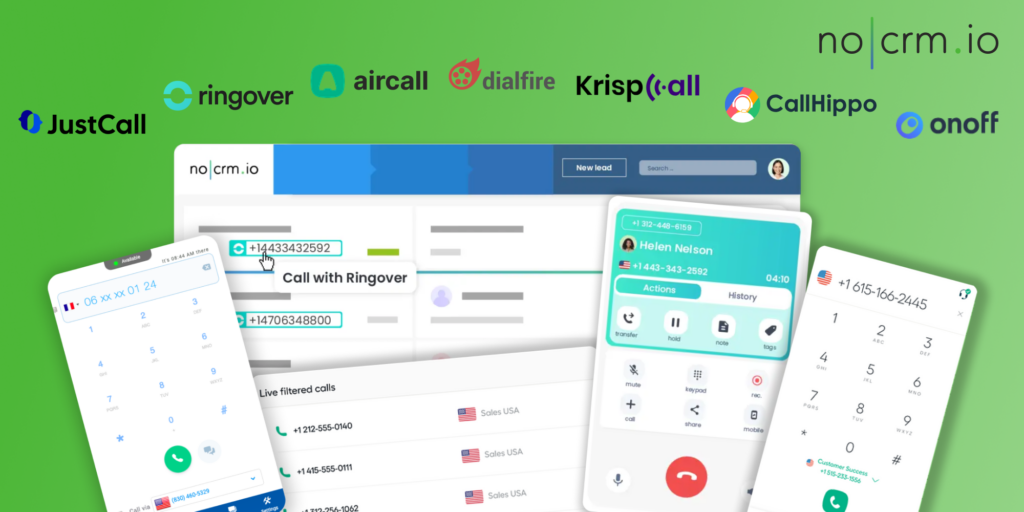
No more bouncing between different platforms and trying to manually keep track of everything going on. noCRM helps you do everything from the same place, saving you time and stress and hugely reducing the chances of letting promising deals slip through your fingers.
Keeping track of leads is so much more than a simple clerical task. It should really be considered as a fundamental strategic component of your team’s overall success. Implementing a robust system to monitor and manage your leads will equip your sales reps with all the tools they need to nurture prospect relationships and eventually propel them toward signing on the dotted line. And once you’ve got a firm handle on the right CRM for the job, you’ll be able to enhance your productivity even further, giving yourself the killer edge that can make all the difference in the fast-paced world of modern sales.
FAQ
Lead tracking involves monitoring every interaction with prospects from initial contact to deal closure. It’s important because it helps sales teams nurture relationships, reduce errors, and improve conversion rates.
A business can qualify a lead by evaluating interest levels, demographic information, and behavioral actions, such as downloading resources or requesting demos, to prioritize the most promising prospects.
A CRM system offers benefits such as storing detailed contact information, recording interactions, monitoring lead progress, and automating tasks, which enhance efficiency and organization in the sales process.


